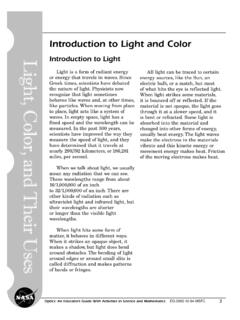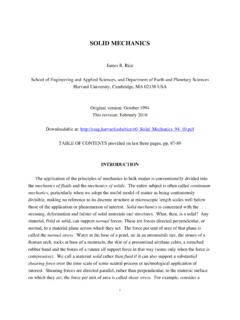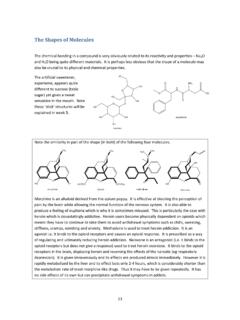Transcription of Physics 100A Homework 11- Chapter 11 (part 1) Finding ...
1 Physics 100A Homework 11- Chapter 11 (part 1) Finding Torque A force of magnitude making an angle FGF with the x axis is applied to a particle located along axis of rotation A, at Cartesian coordinates (0 in the figure. The vector , 0)FG lies in the xy plane, and the four axes of rotation A, B, C, and D all lie perpendicular to the xy plane. Copyright 2010 Pearson Education, Inc. All rights reserved. This material is protected under all copyright laws as they currently exist. No portion of this material may be reproduced, in any form or by any means, without permission in writing from the publisher.
2 11 1 A) What is the torque A about axis A due to the force FG? The force passes through the point A, so there is no arm and the torque is zero. B) What is the torque B about axis B due to the force FG? (B is the point at Cartesian coordinates (0 , located a distance b from the origin along the y axis .) , )b The magnitude of the torque is rF = where F is the component of the force perpendicular to . r Note that the torque can also be calculated with the concept of the moment arm rF =, where is the component of the radial vector perpendicular to the direction of the force.
3 R The answer is the same. In most problems it is easier to visualize the perpendicular component of the force. We will use what is simplest in a given problem. rb= cosFF = The direction of the torque follows the convention: positive if it produces a counterclockwise rotation and negative if it produces a clockwise rotation. cosBbF = C) What is the torque C about axis C due to the force FG? (C is the point at Cartesian coordinates (0 , located a distance from the origin along the x axis .) , )ccrc= sinFF = The torque produces a clockwise rotation about C.
4 SinccF = D) What is the torque D about axis D due to the force FG? (D is the point located a distance d from the origin and making an angle with the x axis .) The angle between and the vector AD is (FGrG ). sin()FF = and the rotation is counterclockwise Chapter 11: Rotational Dynamics and Static Equilibrium James S. Walker, Physics , 4th Edition sin()DdF = Torque Magnitude Ranking Task The wrench in the figure has six forces of equal magnitude acting on it. Rank these forces (A through F) on the basis of the magnitude of the torque they apply to the wrench, measured about an axis centered on the bolt.
5 The larger the radius, the larger the torque magnitude. The larger the perpendicular projection onto the radial direction, the larger the torque. Then in decreasing order: D, (B,E), F, A, C Torque! The car shown in the figure has mass (this includes the mass of the wheels). The wheels have radius , mmrass Wm , and moment of inertia2 WIkm=me that the axles apply the same torque r. Assu to all four wheels. For simplicity, also assume that the weight is distributed uniformly so that all the wheels experience the same normal reaction from the ground, and so the same frictional force.
6 Copyright 2010 Pearson Education, Inc. All rights reserved. This material is protected under all copyright laws as they currently exist. No portion of this material may be reproduced, in any form or by any means, without permission in writing from the publisher. 11 2 A) If there is no slipping, a frictional force must exist between the wheels and the ground. In what direction does the frictional force act? Take the positive x direction to be to the right. The frictional force acts in the positive x direction. B) Use Newton's laws to find an expression for the net external force acting on the car.
7 Ignore air resistance. The vertical forces balance. The net force is in the horizontal direction: F where 4total=ff is the friction force in each wheel. Chapter 11: Rotational Dynamics and Static Equilibrium James S. Walker, Physics , 4th Edition C) Use Newton's laws to find an expression for , the normal force on each wheel. Forces in the y direction: 40wheelNmg = where is the normal force on each wheel that we take to be equal since the weight is equally distributed. wheelN/4wheelNmg= D) Now assume that the frictional force f is not at its maximum value.
8 What is the relation between the torque applied to each wheel by the axles and the acceleration of the car? Once you have the exact expression for the acceleration, make the approximation that the wheels are much lighter than the car as a whoale. The torque force at each wheel is: rf =. The linear acceleration is obtained from the sum of the forces 4fma= /fr = and / 4fma=, then (/4/mar =) and 4amr = A person slowly lowers a kg crab trap over the side of a dock, as shown in the figure. What torque does the trap exert about the person's shoulder?
9 Picture the Problem: The arm extends out either horizontally and the weight of the crab trap is exerted straight downward on the hand. Strategy:. In this case the downward gravitational force is perpendicular to the radial direction. The rotation in counterclockwise. Solution: The torque: ()()() m kg m/s25 N mrmg === Insight: If the man bent his elbow and brought his hand up next to his shoulder, the torque on the shoulder would be zero but the force on his hand would remain 35 N or lb. ) When a ceiling fan rotating with an angular speed of rad/s is turned off, a frictional torque of N m slows it to a stop in s.
10 Picture the Problem: The ceiling fan rotates about its axis , decreasing its angular speed at a constant rate. Strategy: Determine the angular acceleration using equation 10-6 and then use equation 11-4 to find the moment of inertia of the fan. Solution: Solve equation 11-4 for I: ()()() N m kg m0 rad/stIt == = == Insight: Friction converts the fan s initial kinetic energy of JI =into heat. Rotational work will be examined in more detail in section 11-8. Copyright 2010 Pearson Education, Inc.















